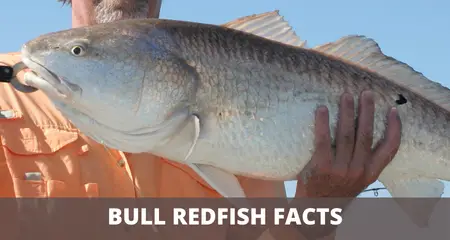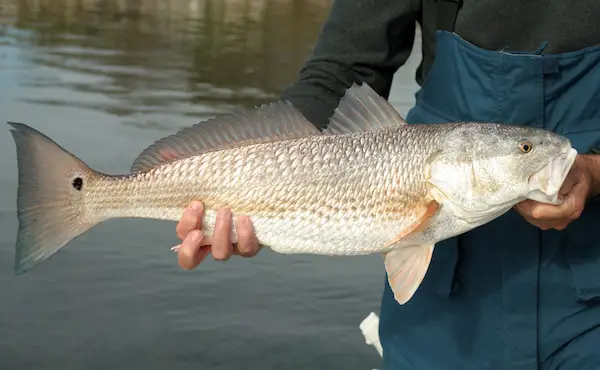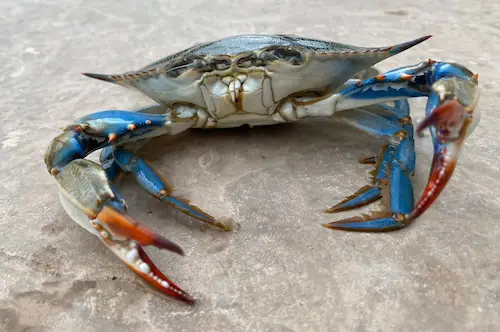Essential Bull Redfish Facts (And How To Catch Them)
UPDATED 03 NOVEMBER 2023
by Robert Ceran
Catching a trophy sized bull redfish is on the bucket list of every saltwater angler.
However, while it’s pretty straightforward to catch puppy red drum in creeks and nearshore waters, catching bull reds is much harder.
This is because big bull redfish live in deeper water and are much more elusive than puppy redfish.

In this article we’ll go over the key bull redfish facts that you need to know, and will also cover where to find them and how to catch them.
What is a bull redfish?
A bull redfish is an adult redfish that’s bigger than 27 inches long. The term bull redfish can thus be used as a synonym for mature redfish, while redfish shorter than 27 inches are often referred to as puppy redfish, or puppy drums.
However, some anglers define a bull redfish as any redfish that’s bigger than the slot limit of their state, which varies slightly from state to state.
Also, a few redfish anglers who specialize in targeting trophy redfish define a bull redfish as a fish that’s over 35 inches long.
How long is a bull redfish?
A bull redfish is at least 27 inches long or longer. Redfish reach this length when they are about 4 years old, and they become sexually mature at this point, weighing about 8 to 9 pounds.
Most redfish over 27 inches are protected by state redfish size limits, which means you can only keep slot fish smaller than that.
Fortunately, redfish are fast growing fish, which is great for conservation purposes.
What is the difference between a redfish and a bull red?
The main difference between a bull red and a redfish is that a bull red is an adult fish, while a redfish is a juvenile or sub-adult fish. And as discussed above, bull reds are defined as being bigger than 27 inches, while redfish are smaller than 27 inches.

In addition to their size difference, bull reds and redfish also live in largely non-overlapping habitats, and tend to forage on different food. Juvenile redfish grow up in creeks, estuaries, and shallow grass flats, where they feed on zooplankton, small crabs, and fish fry.
Bull reds, on the other hand, are sexually mature fish that move into deeper offshore waters, where they feed on fully grown crabs and small to medium sized fish such as mullet, croaker, and pinfish.
Are bull redfish male or female?
Bull redfish can be either male or female, and if you catch a bull red between 27 and 35 inches in length, there’s an equal chance it could be either male or female.
However, when bull redfish reach sizes over 35 inches, they are much more likely to be female than male. This is because male redfish slow down their growth significantly after they reach 35 inches, while female redfish continue growing rapidly throughout their life.
So if you catch a giant bull red over 35 inches, you’re probably dealing with a female red drum.
How big do bull redfish get?
Big bull reds can reach enormous sizes north of 45 inches and 90 pounds. However, these huge sizes are very rare, while fish weighing over 30 pounds are relatively common.
What is the world record bull redfish?
The all-tackle world record bull redfish is 94 pounds and 2 ounces, and was caught from the shore by David Deuel in 1984 in Hatteras, North Carolina. The monster redfish measured 57 inches in length, and had a girth of 38 inches.
Cape Hatteras in North Carolina is world famous for its giant bull redfish caught with surf casting every year, and produces many trophy sized bull reds every season.
Are bull redfish good to eat?
Bull redfish are not very good to eat, since their meat is tough and chewy compared to younger redfish. So if you want to eat redfish, it’s definitely better to stick to puppy red drum, which have soft flaky meat with a delicate flavor.
The fact that bull reds aren’t very good table fare is another reason to release them unharmed after you catch them, in addition to the fact that they are the breeding stock of the redfish population.
Can you keep bull reds?
Most states don’t allow you to keep bull reds, and instead require you to return them to the water immediately after catching them. The exceptions to this are Louisiana, Mississippi and Alabama, which allow you to keep one bull redfish per day, as part of your daily bag.

In addition to these 3 states, Texas allows you to keep one bull redfish per year. All other states have redfish size limits that don’t allow you to keep fish over their slot limit.
A slot limit is designed to protect both undersized redfish, as well as mature bull redfish, which form the breeding stock of the red drum population.
Where can you find bull red drum?
When bull reds reach sexual maturity, most of them move offshore from the shallow estuaries where they spent their youth.
Bull redfish congregate in giant schools that can consist of thousands of fish, and are most often found in the deep parts of passes, coastal bays, and river mouths, in water that’s 30 to 50 feet deep.
It can be very challenging to find these large schools, but a great trick is to look for birds diving down on schools of baitfish that several bull reds have pushed up to the surface.
Another sign to look for when redfish are feeding at the bottom is a cloud of mud rising up to the surface. This is a sure sign that there’s a school of bull reds churning up the bottom while foraging.
Also, one of the most useful tools to find bull red drum is a high quality fish finder with side imaging, since this allows you to scan large areas in search of redfish.
Finally, not all bull redfish move offshore, and you can also encounter some individuals foraging in shallow water closer to shore.
What is a bull redfish run?
The term bull redfish run refers to the annual movement of bull redfish schools into shallow coastal waters during the spawning season.
In most areas this occurs in late summer and early fall, from late August through early October. A redfish spawning run is thought to be triggered by the cooling of the water temperatures in early fall.
When such a fall run occurs in your area, this usually signifies the peak redfish fishing season of the year. At this time it’s possible to catch trophy sized redfish from the shore in many places, such as inlets, along the beaches, or even from a jetty or pier.
How do you catch bull redfish?
The hardest part of bull redfish fishing is finding them. So if you want to catch bull reds, it’s usually a good idea to hire a fishing guide or a charter boat specialized in catching redfish.
Once you’ve found a school of big reds, catching them is usually not that hard, especially if they’re actively feeding.
Rod and reel setup
You’ll need to use heavy redfish tackle when targeting giant reds, since they put up a determined fight and use the currents to their advantage.
I recommend a 7 foot heavy power spinning rod with moderate fast action, paired with a 6,000 to 7,000 size spinning reel spooled with 50 lb pound test braid.
Rigging for bull reds
If you’re fishing with natural bait or cut bait, one of the best rigs for bull redfish is the dropper loop rig.
This consists of a heavy 6 to 10 oz lead weight at the end of a 30 to 50 lb test fluorocarbon leader, with a dropper loop and a circle hook tied about 1 to 2 feet above the weight.
Alternatively, you can also use a three way swivel to create a similar setup that will allow you to present your bait just above the bottom, which is often the ideal strike zone for bull reds.
What size hooks should you use for bull reds?
The ideal hook size for bull reds ranges between 3/0 and 10/0. All of these hook sizes are strong enough to haul in big reds without being bent open.
However, the exact size you’ll want to choose depends on the type of bait that you’re using. In general, the size of the hook should match the size of the bait.
Bait
Since redfish love to eat crabs, one of the best baits to use for big redfish is fresh cut blue crab or bunker crab.

You can cut the crab in half, or use it whole. In either case, it’s good to remove the top plate, since that will help to release scents into the water that attract the redfish.
Alternatively, you can also use cut bait, such as ladyfish strips, or whole mullet, croakers, or pogies.
If you find the fish are finicky, and don’t want your dead bait, another option is to fish with live bait, such as a live shrimp, menhaden, or croaker rigged on light tackle with a single size 3/0 circle hook without a sinker.
Lures
When bull redfish are feeding near the surface, a great way to catch them is with topwater lures, such as poppers and spooks.
Make sure to cast your topwater lure off to the side of the school, and not right into the middle of it, since that will tend to scare them away.
However, when bull redfish are holding close to the bottom, the best lures to use are bucktail jigs or regular jig heads rigged with soft plastic trailers, such as a Z-Man Diezel MinnowZ.
Choose heavy jigs ranging from 1 to 8 ounces, to help you get down into the strike zone.
How to catch bull reds in the surf
In order to catch bull reds with surf fishing, it’s best to concentrate on the months when they are holding close to the shore. In most areas this is going to be in early fall, usually in September and October.
One of the best ways to catch bull reds with surf fishing is with the fish finder rig, or variations thereof.
This rig is specifically designed to be cast from shore, and allows you to reach holes and ledges that are on the other side of the breaking surf.
Bait your hook with cut crab or cut fish and cast it out to promising structures on the far side of the surf.
When you’re waiting for bites, retrieve your rig periodically to re-bait the hook and to make sure your rig didn’t get tangled during the cast.
If you’re new to catching redfish and have problems telling them apart from other fish, check out our article on how to distinguish red snapper vs redfish.
